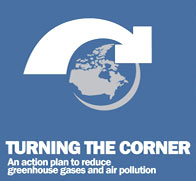
Canada Climate Initiative Archives
NRTEE Slams Government's Kyoto Act Plan According to Canada's National Round Table on the Environment and the Economy (NRTEE), the plan prepared by the federal government in response to its obligations under the Kyoto Protocol Implementation Act exaggerates benefits of three of its nine climate-change programs and fails to provide sufficient information to support the other six programs.
According to Canada's National Round Table on the Environment and the Economy (NRTEE), the plan prepared by the federal government in response to its obligations under the Kyoto Protocol Implementation Act exaggerates benefits of three of its nine climate-change programs and fails to provide sufficient information to support the other six programs.Further, the August 2007 plan (see section, 'Canadian Government Responds to Kyoto Act') will not result in sufficient greenhouse gas (GHG) emissions reductions for Canada to meet its target for the 2008-2012 commitment period under the Kyoto Protocol. The NRTEE was careful not to pass judgment on the advisability of any Canadian government initiatives, yet the report is highly critical of the government's methods and assumptions in projecting its programs' results. The report says the government is using misleading methods, and notes "systematic" exaggeration, "double accounting,", "important inconsistency" and "overestimated" reductions that result in false conclusions about effectiveness of its plan. Authors of the NRTEE report, which included some of Canada's top business and environmental leaders, recommend the government pay closer attention to "transparency and clarity" when presenting greenhouse-gas reductions, and "consistency" in accounting for those reductions from department to department. The Roundtable did, however, note the government plan would, over time, result in significant emissions reductions. Under the Kyoto Protocol Implementation Act, the Roundtable was required to advise the government on the effectiveness of its climate-change plan within 30 days of its release. View September 2007 National Round Table on the Environment and the Economy (NRTEE) report, Response of the National Round Table on the Environment and the Economy to its Obligations Under the Kyoto Protocol Implementation Act Visit Climate Action Network Canada View September 22, 2007 Toronto Star article View September 21, 2007 Canadian Press article in the Toronto Star Sources: Canadian Press, Toronto Star, NRTEE, CANet
Canadian Government Responds to Kyoto Act In August 2007 Canada's Environment Minister John Baird released the Government's response to the legal requirement under Bill C-288, The Kyoto Protocol Implementation Act, to "ensure that Canada meets its obligations under Article 3, paragraph 1, of the Kyoto Protocol" within two months from when the legislation comes into force (June 22, 2007). In August 2007 Canada's Environment Minister John Baird released the Government's response to the legal requirement under Bill C-288, The Kyoto Protocol Implementation Act, to "ensure that Canada meets its obligations under Article 3, paragraph 1, of the Kyoto Protocol" within two months from when the legislation comes into force (June 22, 2007).A Climate Change Plan for the Purposes of the Kyoto Protocol Implementation Act 2007 was posted on the Environment Canada website on August 21, 2007. View the Environment Canada document, A Climate Change Plan for the Purposes of the Kyoto Protocol Implementation Act 2007 Minister Baird's response has been characterized as "thumbing its nose" at the opposition's legislative attempts to force compliance with the Kyoto Protocol. Minister Baird's plan simply re-packages its April 2007 climate change plan, Turning the Corner, and does not outline a path for Canada to meet its greenhouse gas emissions reduction targets under the Kyoto Protocol. View the August 21, 2007 Canadian Press article on CTV News The plan repeats the argument that trying to meet Kyoto by 2012 would wreak economic disaster on the Canadian economy. This argument has been disputed by many experts and following the release of the Bill C-288 plan, a federal analysis questions the validity of Minister Baird's economic arguments against meeting Kyoto obligations. A four-page briefing note on the impact of Canada's international climate-change obligations said nothing to support Mr. Baird's warnings that the law could lead to massive job losses, rising energy prices and a recession. The document was obtained through and Access to Information request. View the August 22, 2007 Ottawa Citizen article Climate Action Network (CAN) Canada, a nation-wide network comprised of over 60 national and regional environmental groups, said the federal government's climate change plan fails to offer a credible plan to meet Kyoto and makes an increase in emissions in Canada an certainty. "The government's response to the Kyoto law is confused, unfocussed and illegal," said Steven Guilbeault, Greenpeace Canada. "While the urgency of dealing with climate change has never been clearer, the government has chosen to hide behind a package of inadequate old announcements. This is simply unacceptable." View the August 22, 2007 Climate Action Network Canada press release The Liberals, NDP and Bloc Quebecois pushed Bill C-288 through the House of Commons in June 2007 without the support of the governing Conservatives. Sources: CTV News, Ottawa Citizen, Government of Canada
Bill C-288 - Kyoto Targets Become Law |
|||||
 By Frederick Deligne politicalcartoons.com larger version |
The Canadian Senate voted to pass the Liberal private member's Bill C-288 Friday, June 22, 2007, which obligates the Canadian government to meet Kyoto Protocol greenhouse gas emissions reduction targets. Bill C-288 had previously passed in the House of Commons. For Canada, this target is a 6% cut in greenhouse gas emissions from 1990 levels by 2012. Canada made its international commitment to meeting emissions reduction targets under Kyoto when it signed on and ratified the Kyoto Protocol. |
||||
When it came into force in February 2005, Kyoto became legally binding for countries that ratified it. The passage of Bill C-288 is another legal affirmation of Canada's commitment to reduce emissions and comply with Kyoto provisions. Liberal MP Pablo Rodriguez originally introduced Bill C-288, The Kyoto Protocol Implementation Act, May 17, 2006. Its provisions require the government to prepare a Climate Change Plan to "ensure that Canada meets its obligations under Article 3, paragraph 1, of the Kyoto Protocol" within two months from when the legislation comes into force (June 22, 2007). It also obligates the government to bring in regulations to "ensure that Canada fully meets its obligations" under Kyoto. The bill is controversial because:
View June 22, 2007 CTV News article View June 22, 2007 Agence France-Presse article on Raw Story  Download June 21, 2007 Winnipeg Free Press article (DOC) Download June 21, 2007 Winnipeg Free Press article (DOC)View text of Bill C-288 - An Act to ensure Canada meets its global climate change obligations under the Kyoto Protocol - as passed by the House of Commons View information on the history and status of Bill C-288 Sources: CTV News, Agence France-Presse, Canadian Press |
|||||
Clean Air Act Revised by All-Party Legislative CommitteeThe re-vamped Bill C-30 includes almost 100 amendments (most brought forward by opposition party members) and bears little resemblance to the bill first tabled by the Conservatives in October 2006. Among the key changes and measures included in Bill C-30:
The Conservative government has not made it clear whether and how it will act to move the re-written Bill C-30 through the legislative process. The government itself referred the legislation to the House committee, resulting in MPs from all political parties spending countless hours of time and energy on the amendment process, as well as expenditures to hold hearings. However, the Conservatives are not under any procedural obligation to bring the legislation before the House of Commons for a vote (second reading). An April 30, 2007 article quotes Government House Leader Peter Van Loan as saying that the government has "no intention" of passing Bill C-30, which means that the bill will die on the Order Paper. View the March 29, 2007 amendments to Bill C-30 Clean Air Act - Legislation to be ReviewedThe Clean Air Act:
All three opposition parties in the House of Commons said they would vote against the bill. In November 2006, Prime Minister Stephen Harper agreed to an NDP demand to put the Clean Air Act before a House of Commons committee. The bill will undergo the unusual step of being reviewed by an all-party committee before second reading, It is expected that opposition critics will overhaul the bill in the committee process.
Environment Commissioner's Wake-Up Call Canada's environment commissioner Johanne Gelinas used an audit of the former government's failure to reduce emissions to recommend that Canada's current federal government act swiftly against the pending climate crisis.
Canada's environment commissioner Johanne Gelinas used an audit of the former government's failure to reduce emissions to recommend that Canada's current federal government act swiftly against the pending climate crisis.The report, released September 28, 2006, said Prime Minister Stephen Harper and his government should not continue to use the lack of progress on Canada's Kyoto targets as an excuse to abandon the international pact. The Commissioner urged government to create a credible, realistic and clear plan with short- and long-term goals to reduce greenhouse gas emissions. View the 2006 Report of the Commissioner of the Environment and Sustainable Development View the September 28, 2006 Commissioner of the Environment and Sustainable Development press release Source: Commissioner of the Environment and Sustainable Development
Climate Change Web Pages GoneOn June 30, 2006, Canada's federal Conservative government quietly shut down the main public climate change website run by the Department of Natural Resources.http://www.climatechange.gc.ca and http://climatechange.nrcan.gc.ca are no longer available; visitors are directed to the main sites for Environment Canada and Natural Resources Canada. Energy Efficiency Programs SlashedThe similar Energuide program for low-income households had its entire budget of more than $550 million cut. Four other programs have lost most, or all, of their funding. They include everything from money to develop new kinds of renewable energy, to a program to help people switch to more efficient furnaces. The cuts add up to just under $1 billion over the next five years. Source: CBC
Climate Change Programs AxedOnly $375-million was approved for climate spending, with most of the funds going to cover staff salaries until the government determines next steps. As a result, much of the funds required to implement programs has vanished. Some of the cuts resulted from government's failure to renew multi-year funding programs established in 2000, which expired with the fiscal year on March 31st. View the April 13, 2006 Natural Resources Canada backgrounder The cuts included: 
The leaked Cabinet documents also alluded to the possibility of Canada clawing back $260-million pledged to the United Nations to fund international climate-change programs. Sources: Globe and Mail, Government of Canada, CBC
Transit Subsidies Have Negligible Impact The Conservatives' campaign promise of tax breaks for transit passes will cost up to $2-billion over five years, but will result in an insignificant cut in greenhouse-gas emissions.
The Conservatives' campaign promise of tax breaks for transit passes will cost up to $2-billion over five years, but will result in an insignificant cut in greenhouse-gas emissions.Information leaked to the press in April 2006 indicated that senior officials in the Environment Ministry told the government its proposed tax credit for transit users will have virtually no impact on greenhouse-gas emissions and only a small effect on riders because the incentives are expected to spur only a small increase in the number of people willing to trade cars for buses and subways. Ministry officials say that, based on a 1997 Canadian study, as well as a U.S. Department of Labour survey in 2004, use can be expected to increase between 2% and 4%, meaning the effect on emissions will be negligible. In contrast, the Canadian Urban Transit Association estimated that the proposed tax break would increase transit use by up to 30 per cent by 2016. The leaked information shows that five transit tax-incentive options are being considered, ranging from a 16-per-cent tax credit for all fares, at a projected cost of $2-billion over five years, to a credit for monthly pass holders only, at $1-billion, to the same credit for high-school students only, at a cost of $90-million. Source: Globe and Mail
Canada Rejects Kyoto Targets On April 7, 2006, Environment Minister Rona Ambrose publicly stated that Canada's federal government had abandoned its commitment to meet its greenhouse gas emission reduction targets under the Kyoto Protocol.
On April 7, 2006, Environment Minister Rona Ambrose publicly stated that Canada's federal government had abandoned its commitment to meet its greenhouse gas emission reduction targets under the Kyoto Protocol."My departmental officials and the department officials from Natural Resources have indicated that it is impossible - impossible for Canada to reach its Kyoto target," she said. The international agreement requires Canada to cut its greenhouse gas emissions to six per cent below 1990 levels by 2012, but since 1990, emissions have gone up, with the latest figures showing an increase of almost 30 per cent. Under Kyoto, countries that fail to meet their emissions targets by the end of the first commitment period (2012) must make up the difference plus a penalty of 30 per cent in the second commitment period. Source: CBC
Regulation of Greenhouse Gases (GHGs) Canadian Environmental Protection Act, 1999 (CEPA 1999) |
|||||
| As part of Canada's climate change plan (2002), Moving Forward on Climate Change: A Plan for Honouring Our Kyoto Commitment, in summer 2005 the federal Government announced its intention to regulate Large Final Emitter (LFE) companies under the Canadian Environmental Protection Act 1999 (CEPA 1999). Large Final Emitters (LFEs) are companies that produce goods through a process that results in significant greenhouse gas (GHG) emissions. These emissions-intensive sectors include primary energy production, electricity production, and selected areas of mining and manufacturing production. Canada's Climate Change Plan (2002) defines large final emitter sectors using the following two criteria:
The process initiated in summer 2005 involved several steps and a series of consultations. In November 2005, six GHGs were added to Schedule 1 of CEPA 1999. There are no compliance or enforcement requirements associated with the addition of the GHGs to Schedule 1 itself; this is an enabling step that sets the stage for the development of regulations. Also in November 2005, the government released a draft for discussion purposes of the proposed regulations common to all sectors that will govern GHG emission reductions from large industrial facilities under CEPA 1999. With the January 2006 election and change in Canada's federal government, no further action on cross-cutting regulations with respect to greenhouse gases has been taken (as of September 2006). |
Chronology of the GHG Regulation Under CEPA 1999 July 15, 2005 - Notice of Intent to Regulate Greenhouse Gas Emissions by Large Final Emitters (LFEs) published in the Canada Gazette, Part I. The Notice outlines how emission-reduction targets would be set, the mechanisms through which LFEs could meet their targets and the preferred regulatory option for implementing the system, under CEPA 1999. A 60-day public comment period followed. A response to the submissions received was published November 26, 2005. A summary of public comments was also published December 2, 2005. September 3, 2005 - Draft Order-in-Council for the addition of six greenhouse gases to Schedule 1 of the CEPA published in the Canada Gazette Part 1 (PDF) November 15, 2005 - Discussion draft of cross-cutting provisions of proposed regulations that will govern GHG emission reductions from large industrial facilities under CEPA 1999 (comment period closed January 12, 2006) The proposed cross-cutting provisions set out elements of the proposed regulations common to all sectors, while the sector-specific regulations will set individual emission targets for the various sectors, as well as specific reporting requirements. Following the public comment, the proposed cross-cutting elements of the regulations are to be published in the Canada Gazette Part I, in early 2006. Also in 2006, a series of sector-specific GHG emission target regulations are to be published for public comment. November 22, 2005 - announcement of the final Order-in-Council for the addition of six greenhouse gases (GHG) to Schedule 1 of CEPA 1999 November 30, 2005 - Final Order-in-Council for the addition of six GHGs to Schedule 1 of CEPA 1999 published in the Canada Gazette Part II (PDF) Updated Schedule 1 of CEPA 1999 July 15, 2006 - Notice with respect to reporting of greenhouse gases (GHGs) for 2006 |
In July 2006, the federal government issued notice to facilities emitting GHG as to emissions reporting requirements for 2006. | |
One-Tonne Challenge In March 2004, the Government of Canada announced its One-Tonne Challenge (OTC) program. The program will invest $45 million over three years in climate change-related communications and challenges individual Canadians to reduce their GHG emissions by one tonne (approximately 20%).
In March 2004, the Government of Canada announced its One-Tonne Challenge (OTC) program. The program will invest $45 million over three years in climate change-related communications and challenges individual Canadians to reduce their GHG emissions by one tonne (approximately 20%).Visit the Canadian Government One-Tonne Challenge web site As of April 2006, funding for the One Tonne Challenge program was 'not renewed' and the program terminated. The link above no longer works; the website has been taken down. National Round Table on the Environment and
|
 2002-2014
2002-2014



 On February 16, 2005, as the Kyoto Protocol took effect, then Prime Minister Paul Martin requested that the NRTEE consider the energy and climate change issues that Canada faces and to develop long-term strategies for a post 2012 world. The NRTEE was asked to provide its perspective on two aspects in particular:
On February 16, 2005, as the Kyoto Protocol took effect, then Prime Minister Paul Martin requested that the NRTEE consider the energy and climate change issues that Canada faces and to develop long-term strategies for a post 2012 world. The NRTEE was asked to provide its perspective on two aspects in particular:  The final report, released in November 2003, Climate, Nature People: Indicators of Canada's Changing Climate describes changes to Canada's climate during the 20th century and reviews trends and implications for twelve climate change indicators. Temperature, precipitation, and other trends identified in the report suggest that climate in many regions of Canada are changing. Individuals, communities, businesses and ecosystems will all be affected, although impacts will vary across the country.
The final report, released in November 2003, Climate, Nature People: Indicators of Canada's Changing Climate describes changes to Canada's climate during the 20th century and reviews trends and implications for twelve climate change indicators. Temperature, precipitation, and other trends identified in the report suggest that climate in many regions of Canada are changing. Individuals, communities, businesses and ecosystems will all be affected, although impacts will vary across the country.